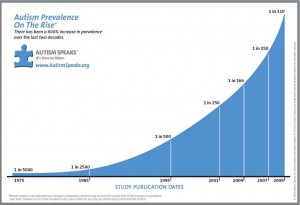 The question is no longer if the diagnosis of autism is rising but why. Over the past 40 years, the rate has increased from around 1975 of 1 in about 5,000 children to, most recently in 2012, a rate of 1 in 68 , the CDC now estimates that 1 in 68.
The question is no longer if the diagnosis of autism is rising but why. Over the past 40 years, the rate has increased from around 1975 of 1 in about 5,000 children to, most recently in 2012, a rate of 1 in 68 , the CDC now estimates that 1 in 68.
The explanations for this surge can roughly be placed into one of two camps: 1) that this increased prevalence is mostly due to an actual rise in the number of new cases, or 2) that at least the lion’s share of the increased numbers is really an artifact due to things like increased surveillance, a lower threshold for diagnosis, more public awareness, and shifts in diagnostic patterns.
This second explanation was recently investigated by Polyak and colleagues from Penn State University. Using the public IDEA Part B database, they examined state-by-state enrollment statistics for school special education services from the years 2000 to 2010 for over 6 million children. Of primary interest were trends regarding the number of children who qualified for services due to having an autistic spectrum diagnosis versus qualifying due to other reasons such as intellectual disability or a specific learning disability.
The total number of children receiving special ed services was not found to change much from 2000 to 2010 (a result I found surprising, personally). Not unexpectedly, the number of children in special ed because of autism rose a total of 331% during this time. However, the number of children receiving services for what has labelled an intellectual disability dropped. Furthermore, the drop in cases of intellectual disability alone could numerically account for nearly two-thirds of the increase in children with autism.
Putting this all together, the authors concluded that their data support the idea that the often mentioned rise in autism is substantially due to a reclassification away from diagnoses of intellectual disability or a specific learning disability and toward autism.
A related finding was that there was significant variability from state to state for this inverse trend in the rate of autism versus intellectual disability. Vermont, interestingly, showed this trend more than all other states with the exception of North Dakota, while states like California and Texas did not. The authors speculated that the variability was related to differences in special education policy. In another informative table, the authors summarize the rate of autism features among individuals with various known (and named) genetic conditions with the suggestion here being that there is quite of bit of subjectivity going into the decision to invoke autism as a primary diagnosis versus something else.
The evidence presented here is compelling but, of course, circumstantial. A rise in actual autism cases has been linked to increased parental age, and many individuals and groups continue to contend that everything from environmental toxins to new infectious agents may be behind the rise.
Obviously there is room for some middle ground here. While this study cannot rule out the possibility that there are more “true” cases of autism than in the past, evidence does seem to be mounting that at least a significant portion of this increase is due to other factors.
Reference
Polyak A, et al. Comorbidity of Intellectual Disability Confounds Ascertainment of Autism: Implications for Genetic
Diagnosis. Am J Med Genetics 2015; epub ahead of print.

